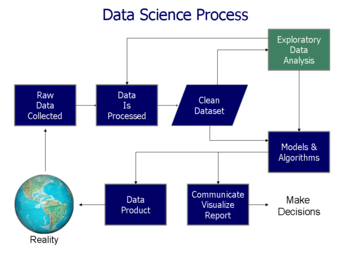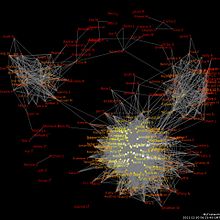Chapter 6: The Importance of Data
21 Data Visualization
From wikipedia: https://en.wikipedia.org/wiki/Data_visualization
Data visualization or data visualisation is viewed by many disciplines as a modern equivalent of visual communication. It involves the creation and study of the visual representation of data, meaning “information that has been abstracted in some schematic form, including attributes or variables for the units of information“.[1]
A primary goal of data visualization is to communicate information clearly and efficiently via statistical graphics, plots and information graphics. Numerical data may be encoded using dots, lines, or bars, to visually communicate a quantitative message.[2] Effective visualization helps users analyze and reason about data and evidence. It makes complex data more accessible, understandable and usable. Users may have particular analytical tasks, such as making comparisons or understanding causality, and the design principle of the graphic (i.e., showing comparisons or showing causality) follows the task. Tables are generally used where users will look up a specific measurement, while charts of various types are used to show patterns or relationships in the data for one or more variables.
Data visualization is both an art and a science. It is viewed as a branch of descriptive statistics by some, but also as a grounded theory development tool by others. The rate at which data is generated has increased. Data created by internet activity and an expanding number of sensors in the environment, such as satellites, are referred to as “Big Data”. Processing, analyzing and communicating this data present a variety of ethical and analytical challenges for data visualization. The field of data science and practitioners called data scientists have emerged to help address this challenge.[3]
Overview
Data visualization refers to the techniques used to communicate data or information by encoding it as visual objects (e.g., points, lines or bars) contained in graphics. The goal is to communicate information clearly and efficiently to users. It is one of the steps in data analysis or data science. According to Friedman (2008) the “main goal of data visualization is to communicate information clearly and effectively through graphical means. It doesn’t mean that data visualization needs to look boring to be functional or extremely sophisticated to look beautiful. To convey ideas effectively, both aesthetic form and functionality need to go hand in hand, providing insights into a rather sparse and complex data set by communicating its key-aspects in a more intuitive way. Yet designers often fail to achieve a balance between form and function, creating gorgeous data visualizations which fail to serve their main purpose — to communicate information”.[4]
Indeed, Fernanda Viegas and Martin M. Wattenberg have suggested that an ideal visualization should not only communicate clearly, but stimulate viewer engagement and attention.[5]
Not limited to the communication of an information, a well-crafted data visualization is also a way to a better understanding of the data (in a data-driven research perspective),[6] as it helps uncover trends, realize insights, explore sources, and tell stories.[7]
Data visualization is closely related to information graphics, information visualization, scientific visualization, exploratory data analysis and statistical graphics. In the new millennium, data visualization has become an active area of research, teaching and development. According to Post et al. (2002), it has united scientific and information visualization.[8]
Characteristics of effective graphical displays
Charles Joseph Minard‘s 1869 diagram of Napoleon’s March – an early example of an information graphic.
The greatest value of a picture is when it forces us to notice what we never expected to see.
Professor Edward Tufte explained that users of information displays are executing particular analytical tasks such as making comparisons or determining causality. The design principle of the information graphic should support the analytical task, showing the comparison or causality.[10]
In his 1983 book The Visual Display of Quantitative Information, Edward Tufte defines ‘graphical displays’ and principles for effective graphical display in the following passage: “Excellence in statistical graphics consists of complex ideas communicated with clarity, precision and efficiency. Graphical displays should:
- show the data
- induce the viewer to think about the substance rather than about methodology, graphic design, the technology of graphic production or something else
- avoid distorting what the data has to say
- present many numbers in a small space
- make large data sets coherent
- encourage the eye to compare different pieces of data
- reveal the data at several levels of detail, from a broad overview to the fine structure
- serve a reasonably clear purpose: description, exploration, tabulation or decoration
- be closely integrated with the statistical and verbal descriptions of a data set.
Graphics reveal data. Indeed graphics can be more precise and revealing than conventional statistical computations.”[11]
For example, the Minard diagram shows the losses suffered by Napoleon’s army in the 1812–1813 period. Six variables are plotted: the size of the army, its location on a two-dimensional surface (x and y), time, direction of movement, and temperature. The line width illustrates a comparison (size of the army at points in time) while the temperature axis suggests a cause of the change in army size. This multivariate display on a two dimensional surface tells a story that can be grasped immediately while identifying the source data to build credibility. Tufte wrote in 1983 that: “It may well be the best statistical graphic ever drawn.”[11]
Not applying these principles may result in misleading graphs, which distort the message or support an erroneous conclusion. According to Tufte, chartjunk refers to extraneous interior decoration of the graphic that does not enhance the message, or gratuitous three dimensional or perspective effects. Needlessly separating the explanatory key from the image itself, requiring the eye to travel back and forth from the image to the key, is a form of “administrative debris.” The ratio of “data to ink” should be maximized, erasing non-data ink where feasible.[11]
The Congressional Budget Office summarized several best practices for graphical displays in a June 2014 presentation. These included: a) Knowing your audience; b) Designing graphics that can stand alone outside the context of the report; and c) Designing graphics that communicate the key messages in the report.[12]
Visual perception and data visualization
A human can distinguish differences in line length, shape orientation, and color (hue) readily without significant processing effort; these are referred to as “pre-attentive attributes.” For example, it may require significant time and effort (“attentive processing”) to identify the number of times the digit “5” appears in a series of numbers; but if that digit is different in size, orientation, or color, instances of the digit can be noted quickly through pre-attentive processing.[14]
Effective graphics take advantage of pre-attentive processing and attributes and the relative strength of these attributes. For example, since humans can more easily process differences in line length than surface area, it may be more effective to use a bar chart (which takes advantage of line length to show comparison) rather than pie charts (which use surface area to show comparison).[14]
Human perception/cognition and data visualization
There is a human side to data visualization. With the “studying [of] human perception and cognition …” we are better able to understand the target of the data which we display.[15] Cognition refers to processes in human beings like perception, attention, learning, memory, thought, concept formation, reading, and problem solving.[16] The basis of data visualization evolved because as a picture is worth a thousand words, data displayed graphically allows for an easier comprehension of the information. Proper visualization provides a different approach to show potential connections, relationships, etc. which are not as obvious in non-visualized quantitative data. Visualization becomes a means of data exploration. Human brain neurons involve multiple functions but 2/3 of the brain’s neurons are dedicated to vision.[17] With a well-developed sense of sight, analysis of data can be made on data, whether that data is quantitative or qualitative. Effective visualization follows from understanding the processes of human perception and being able to apply this to intuitive visualizations is important. Understanding how humans see and organize the world is critical to effectively communicating data to the reader. This leads to more intuitive designs.
Data presentation architecture
A data visualization from social media
Data presentation architecture (DPA) is a skill-set that seeks to identify, locate, manipulate, format and present data in such a way as to optimally communicate meaning and proper knowledge.
Historically, the term data presentation architecture is attributed to Kelly Lautt:[23] “Data Presentation Architecture (DPA) is a rarely applied skill set critical for the success and value of Business Intelligence. Data presentation architecture weds the science of numbers, data and statistics in discovering valuable information from data and making it usable, relevant and actionable with the arts of data visualization, communications, organizational psychology and change management in order to provide business intelligence solutions with the data scope, delivery timing, format and visualizations that will most effectively support and drive operational, tactical and strategic behaviour toward understood business (or organizational) goals. DPA is neither an IT nor a business skill set but exists as a separate field of expertise. Often confused with data visualization, data presentation architecture is a much broader skill set that includes determining what data on what schedule and in what exact format is to be presented, not just the best way to present data that has already been chosen (which is data visualization). Data visualization skills are one element of DPA.”
Objective
DPA has two main objectives:
- To use data to provide knowledge in the most efficient manner possible (minimize noise, complexity, and unnecessary data or detail given each audience’s needs and roles)
- To use data to provide knowledge in the most effective manner possible (provide relevant, timely and complete data to each audience member in a clear and understandable manner that conveys important meaning, is actionable and can affect understanding, behavior and decisions)




